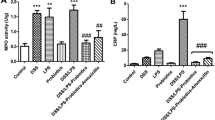Abstract
The immunomodulator effect of Bioflora probiotic on T (CD4+) and B (CD20) lymphocytes in gastrointestinal mucosa and intestinal bacterial translocation was studied using Wistar rats (n = 10 per group). Two experiments were used: (I) stress with immobilization and water immersion at 22°C for 7 h plus the application of indomethacin (Indo) 10 mg/kg SC every 24 h for 3 days (comparator group), and (II) stress experiment I with the addition of 1 mL of Bioflora applied through a orogastric tube every 12 h for 3 days. At the 4th day, in asepsis, a dissection laparotomy of liver, spleen, mesenteric lymphatic nodes, and cecum was performed for microbiological culture, and stomach, ileum, and colon were also dissected for immunohistochemical and quantification of CD4+ and CD20. Findings in experiment I revealed cecum bacterial overdevelopment of 6 × 1010 ± 2.3 × 109 colony-forming units (CFU) (P < 0.01) and positive cultures in liver, spleen, and all mesenteric lymphatic nodes. On the other hand, in the group treated with Probiotic Bioflora, cecum without overdevelopment (3 × 106 ± 1.3 × 105 CFU), negative cultures in liver and spleen, and in lymphatic nodes two positive and eight negative cultures for E. coli and P. vulgaris (P < 0.01) were observed. Immunohistochemistry revealed a relevant increase of T lymphocytes (CD4+) in ileum and colon. Conclusions Bioflora probiotic was shown to be an intestinal immunomodulator that induced increased T (CD4+) lymphocytes that also offer prophylaxis of intestinal bacterial translocation in a stressed rat model.

Similar content being viewed by others
References
Steffen EK, Berg RD (1983) Relationship between cecal population levels of indigenous bacteria and translocation to the mesenteric lymph nodes. Infect Immun 39(3):1252–1259
Edmiston CE Jr, Condon RE (1991) Bacterial translocation. Surg Gynecol Obstet 173(1):73–83
Gianotti L, Munda R, Alexander JW et al (1993) Bacterial translocation: a potential source for infection in acute pancreatitis. Pancreas 8:551–558
Deitch EA, Winterton J, Berg RD (1984) Promotion by burn stress of the translocation of bacteria from the gastrointestinal tracts of mice. Arch Surg 119:116–172
Rush BF, Redan JA, Flanagan JJ et al (1989) Does the bacteremia observed in hemorrhagic shock have clinical significance? A study in germ-free animals. Ann Surg 210:324–347
Alverdy JC, Aoys E, Moss GS (1988) Total parenteral nutrition promotes bacterial translocation from the gut. Surgery 104:185–190
Deitch EA, Taylor M, Grusha MM et al (1989) Endotoxin induces bacterial translocation and increases xanthine oxidase activity. J Trauma 29:1679–1683
Bozer M, Türkcapar N, Bayars S et al (2005) Intraperitoneal hyperthermic perfusion may induce bacterial translocation. Hepato-gastroenterology 52:111–114
Garcia-Tsao G, Lee FY, Barden GF et al (1995) Bacterial translocation to mesenteric lymph nodes is increased in cirrhotic rats with ascites. Gastroenterology 108:1835–1841
Bjarmason I, Takeuchi K, Bjarmason A et al (2004) The G.U.T of gut. Scand J Gastroent 39:807–815
Floch MH, Madsen KK, Jenkins DJA et al (2006) Recommendations for probiotic use. J Clin Gastroenterol 40(3):275–278
Laudanno OM, Vasconcelos L, Catalano J, Cesolari JA (2006) Anti-inflammatory effect of Bioflora probiotic administered orally or subcutaneously with live or dead bacteria. Dig Dis Sci 51(12):2180–2183
Laudanno OM, Cesolari JA, Aramberry L et al (2003) Bioflora prevents intestine ulcers produced by diclofenac in rats. Biocell 27(2):227A
Maden K (2006) Probiotics and the immune response. J Clin Gastroenterol 40(3):232–234
Madsen KL, Doyle JS, Jewell LD et al (1999) Lactobacilli species prevents colitis in interleukin 10 gene-deficient mice. Gastroenterology 116:1107–1114
Demaude J, Salvador Cartier C, Fioramonti J et al (2006) Phenotypic changes in colonocytes following acute stress or activation of mast cells in mice: implications for delayed epithelial barrier dysfunction. Gut 55(5):655–661
Reuter BK, Davies NM, Wallace JL (1997) Nonsteroidal anti-inflammatory drug enteropathy in rats: role of permeability, bacteria, and enterohepatic circulation. Gastroenterology 112:109–117
Loinaz C, Kato T, Nishida S et al (2006) Bacterial infections after intestine and multivisceral transplantation. The experience of University of Miami (1994–2001). Hepato-Gastroenterology 53(68):234–242
Valeur N, Engel P, Carbajal N et al (2004) Colonization and inmunomodulation by Lactobacillus reuteri ATCC 55730 in the human gastrointestinal tract. Appl Environ Microbiol 70(2):1176–1181
Mac Fie J, O´Boyle C, Mitchell C et al (1999) Gut origin of sepsis: a prospective study investigating associations between bacterial translocation, gastric microflora, and septic morbidity. Gut 45:223–228
Isoulauri E, Kirjavainen PV, Salminen S (2002) Probiotics: a role in the treatment of intestinal infection and inflammation? Gut 50:54–59
Cario E (2005) Bacterial interactions with cells of the intestinal mucosa: toll-like receptors and NOD2. Gut 54:1182–1193
Arulampalam V, Greicius G, Pettersson S (2006) The long and winding road to gut homeostasis. Curr Opin Gastroenterol 22(4):349–353
Monteleone G, Fina D, Carusso R, Pallone F (2006) New mediators of immunity and inflammation in inflammatory bowel disease. Curr Opin Gastroenterol 22(4):361–364
Wind-Rotolo M, Blankson JN (2006) HIV-1 infection of CD4+ cells in the gut. Hopkins HIV Rep 18(3):1–8
Kuehn MJ (2006) Genetically engineered probiotic competition. Editorial. Gastroenterology 130(6):1915–1916
Cebra JJ (1999) Influences of microbiota on intestinal immune system development. Am J Clin Nutr 69(suppl):1046–1051
Isolauri E, Sütas Y, Kankaanpää P et al (2001) Probiotics effects on immunity. Am J Clin Nutr 73:5444–5450
Muller CA, Autenrieth IB, Peschel A (2005) Innate defenses of the intestinal epithelial barrier. Cell Mol Life Sci 62:1297–1307
Acknowledgement
The authors would like to thank Dr. Marta Sofía Cassini for her cooperation in the preparation of this paper.
Author information
Authors and Affiliations
Corresponding author
Rights and permissions
About this article
Cite this article
Laudanno, O.M., Cesolari, J.A., Godoy, A. et al. Bioflora Probiotic in Immunomodulation and Prophylaxis of Intestinal Bacterial Translocation in Rats. Dig Dis Sci 53, 2667–2670 (2008). https://doi.org/10.1007/s10620-007-0179-5
Received:
Accepted:
Published:
Issue Date:
DOI: https://doi.org/10.1007/s10620-007-0179-5




